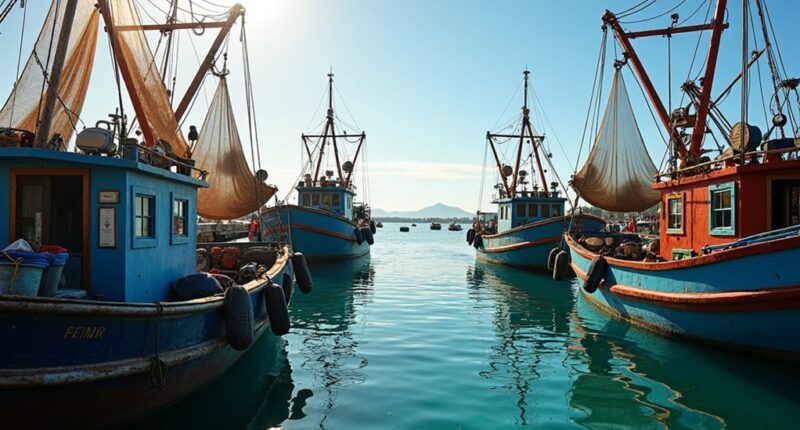Sustainable fisheries management balances ecological health with human needs through science-based approaches. It establishes harvest limits, protected areas, and regulatory frameworks like the Magnuson-Stevens Act to maintain healthy fish populations. This practice supports over 500 million livelihoods worldwide while preserving marine ecosystems and genetic diversity. Despite challenges from climate change and international waters management, emerging technologies and community partnerships offer promising solutions. The future of our seafood depends on these thoughtful conservation strategies.

Consistently overlooked yet fundamentally essential, sustainable fisheries management represents one of humanity’s most pivotal balancing acts with nature. It’s the maritime equivalent of not eating all your Halloween candy in one night—guaranteeing we can still enjoy fish tacos in 2050 while maintaining healthy oceans. This delicate dance involves harvesting fish at rates that maintain populations over time, fundamentally promising future generations they won’t inherit empty seas because we couldn’t control our seafood cravings. Sustainable fishery practices often establish protected areas to preserve critical marine habitats and foster ecosystem recovery.
The magic formula combines long-term planning with science-based approaches. Think of it as a three-legged stool—ecological sustainability, economic viability, and social equity—remove any leg and the whole thing topples over. Effective management preserves not just fish stocks but entire marine ecosystems, the genetic diversity of aquatic species, and the livelihoods of millions who depend on fishing. Sustainable fisheries support over 500 million livelihoods worldwide, with developing countries particularly dependent on these resources.
In the U.S., the Magnuson-Stevens Act serves as the rulebook, with eight Regional Fishery Management Councils acting as referees. NOAA Fisheries, the league commissioner, implements regulations across 461 stocks in 46 management plans. Their trophy case isn’t empty either—47 previously depleted stocks have been rebuilt since 2000.
Science powers these success stories. Stock assessments—fundamentally fish population censuses minus the annoying door-to-door surveyors—provide vital data. Ecosystem-based management approaches consider the whole marine neighborhood, not just the popular fish on the block.
Yet challenges loom like storm clouds on the horizon. Climate change is rewriting ocean rulebooks, international waters remain difficult to police, and balancing immediate economic needs with long-term sustainability requires Solomon-like wisdom.
The future looks promising though. AI and technology are revolutionizing monitoring capabilities—imagine fish wearing tiny digital trackers without the fashion faux pas. Low-carbon fishing practices, strengthened community rights, and industry partnerships create paths forward. By reducing harmful subsidies and embracing sustainable investments, we might just guarantee that seafood remains on menus rather than just in history books.
Frequently Asked Questions
How Do Consumer Choices Impact Sustainable Fishing Practices?
Consumer choices conspicuously influence sustainable fishing practices through market dynamics. When shoppers prioritize sustainably-sourced seafood products, retailers respond by stocking certified options.
The statistics tell the story: 55% of Americans prefer MSC-labeled products, while 48% will buy sustainable seafood to protect fish populations. By diversifying seafood choices beyond popular species like shrimp and salmon, consumers help reduce pressure on overfished stocks, ultimately supporting both marine ecosystems and the livelihoods of 38 million fishery workers worldwide.
What Technologies Are Revolutionizing Fisheries Monitoring?
Modern fisheries monitoring is undergoing a technological revolution. Satellite systems like SAR track vessels in remote areas, while ocean color satellites monitor plankton and water quality. Electronic monitoring with AI-powered cameras reduces the need for human observers, automatically identifying species and tracking catch.
Vessel monitoring systems provide real-time location data to enforce regulations. Emerging innovations like drones, wave gliders, and eDNA metabarcoding are further enhancing our ability to monitor marine ecosystems efficiently.
Can Traditional Fishing Knowledge Contribute to Modern Sustainability Efforts?
Traditional fishing knowledge offers significant contributions to modern sustainability efforts. Indigenous practices like selective harvesting and rotational fishing maintain 85% biodiversity compared to just 45% with modern methods. These time-tested techniques impact only 15% of habitat areas versus 75% for conventional approaches.
When combined with scientific methods and technology, traditional practices create powerful management systems that balance conservation with livelihoods while adapting to climate change impacts—proving that ancient wisdom has a crucial place in future fisheries management.
How Does Climate Change Affect Fisheries Management Strategies?
Climate change forces fisheries management to adapt as fish species chase more comfortable temperatures, heading poleward or deeper. These shifts disrupt traditional management zones, creating jurisdictional headaches akin to trying to enforce property lines on a liquid landscape.
Modern strategies now embrace dynamic allocation systems, real-time data collection, and scenario planning. Managers are fundamentally trading static rulebooks for flexible playbooks, preparing for multiple futures where yesterday’s fishing hotspots might become tomorrow’s marine ghost towns.
What Economic Incentives Promote Sustainable Fishing Practices?
Economic incentives for sustainable fishing include both carrot and stick approaches. Direct payments compensate fishers for conservation efforts and lost earnings from protected areas. Rights-based management, like individual transferable quotas, aligns long-term economic interests with conservation.
Market-based incentives such as green certifications and premium prices for sustainable seafood create financial motivation. Meanwhile, government policies reform harmful subsidies, implement targeted taxes, and establish seasonal restrictions to balance economic and ecological interests.









